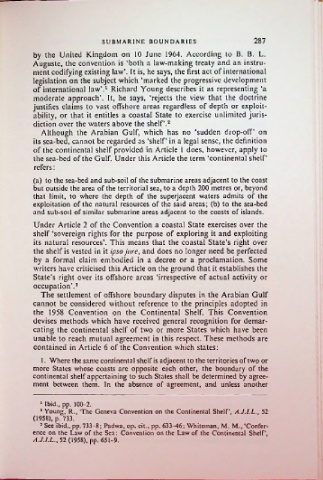Page 351 - The Arabian Gulf States_Neat
P. 351
SUBMARINE BOUNDARIES 287
by the United Kingdom on 10 June 1964. According to B. B. L.
Auguste, the convention is ‘both a law-making treaty and an instru
ment codifying existing law’. It is, he says, the first act of international
legislation on the subject which ‘marked the progressive development
of international law’.1 Richard Young describes it as representing ‘a
moderate approach’. It, he says, ‘rejects the view that the doctrine
justifies claims to vast offshore areas regardless of depth or exploit-
ability, or that it entitles a coastal State to exercise unlimited juris
diction over the waters above the shelf’.2
Although the Arabian Gulf, which has no ‘sudden drop-off’ on
its sea-bed, cannot be regarded as ‘shelf’ in a legal sense, the definition
of the continental shelf provided in Article 1 does, however, apply to
the sea-bed of the Gulf. Under this Article the term ‘continental shelf’
refers:
(a) to the sea-bed and sub-soil of the submarine areas adjacent to the coast
but outside the area of the territorial sea, to a depth 200 metres or, beyond
that limit, to where the depth of the superjacent waters admits of the
exploitation of the natural resources of the said areas; (b) to the sea-bed
and sub-soil of similar submarine areas adjacent to the coasts of islands.
Under Article 2 of the Convention a coastal State exercises over the
shelf ‘sovereign rights for the purpose of exploring it and exploiting
its natural resources’. This means that the coastal State’s right over
the shelf is vested in it ipso jure, and does no longer need be perfected
by a formal claim embodied in a decree or a proclamation. Some
writers have criticised this Article on the ground that it establishes the
Stale’s right over its offshore areas ‘irrespective of actual activity or
occupation’.3
The settlement of offshore boundary disputes in the Arabian Gulf
cannot be considered without reference to the principles adopted in
the 1958 Convention on the Continental Shelf. This Convention
devises methods which have received general recognition for demar
cating the continental shelf of two or more States which have been
unable to reach mutual agreement in this respect. These methods are
contained in Article 6 of the Convention which states:
1. Where the same continental shelf is adjacent to the territories of two or
more States whose coasts are opposite each other, the boundary of the
continental shelf appertaining to such States shall be determined by agree
ment between them. In the absence of agreement, and unless another
1 Ibid., pp. 100-2.
2 Young, R., ‘The Geneva Convention on the Continental Shelf’, A.J.I.L., 52
(1958), p. 733.
3 See ibid., pp. 733-8; Padwa, op. cit., pp. 633-46; Whiteman, M. M., ‘Confer
ence on the Law of the Sea: Convention on the Law of the Continental Shelf’,
A.J.I.L., 52 (1958), pp. 651-9.

